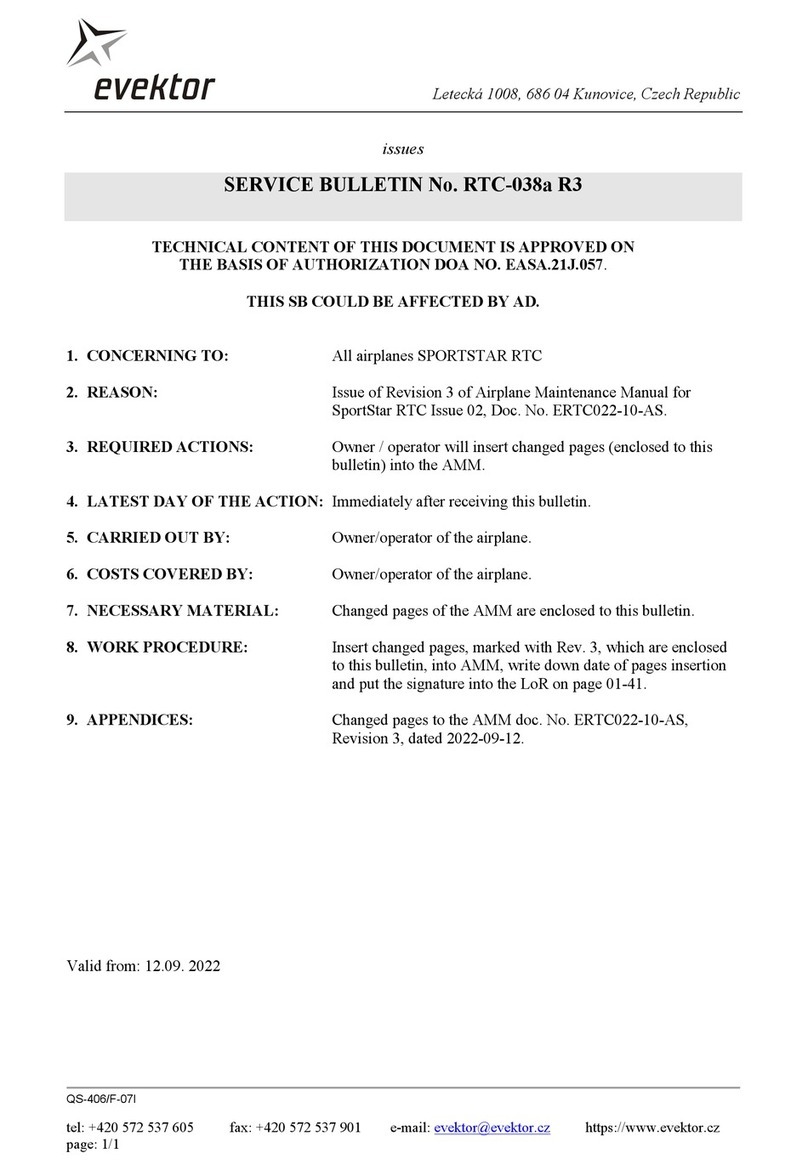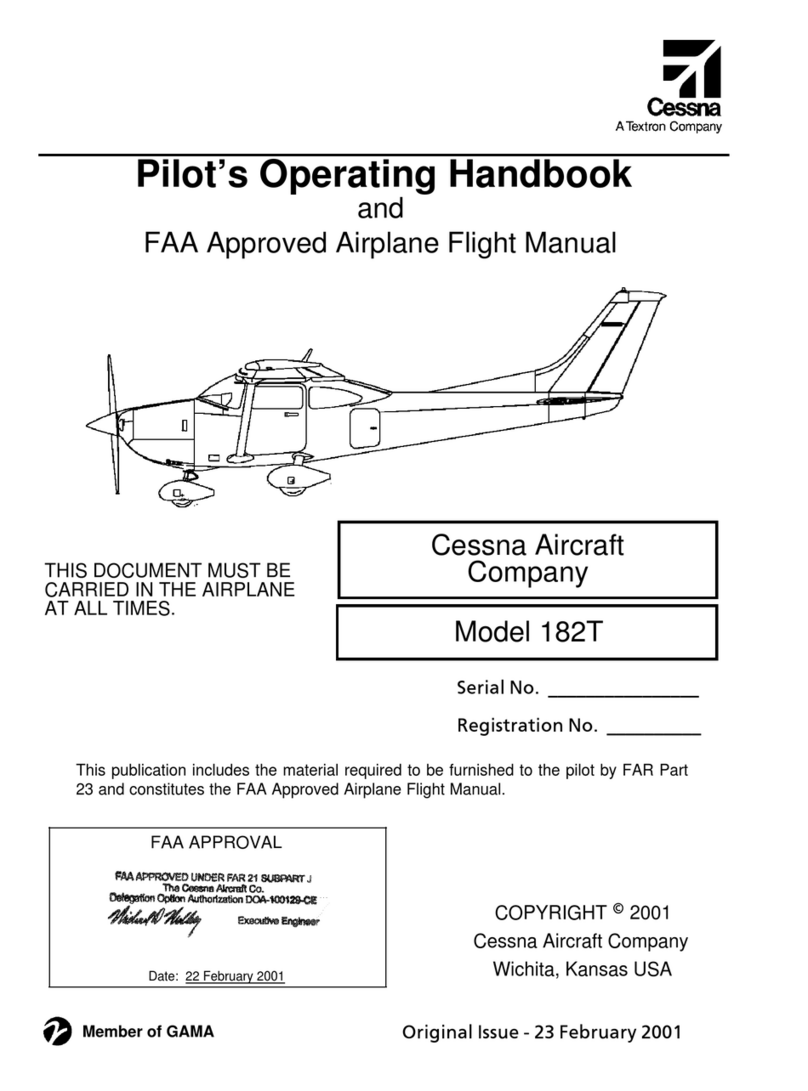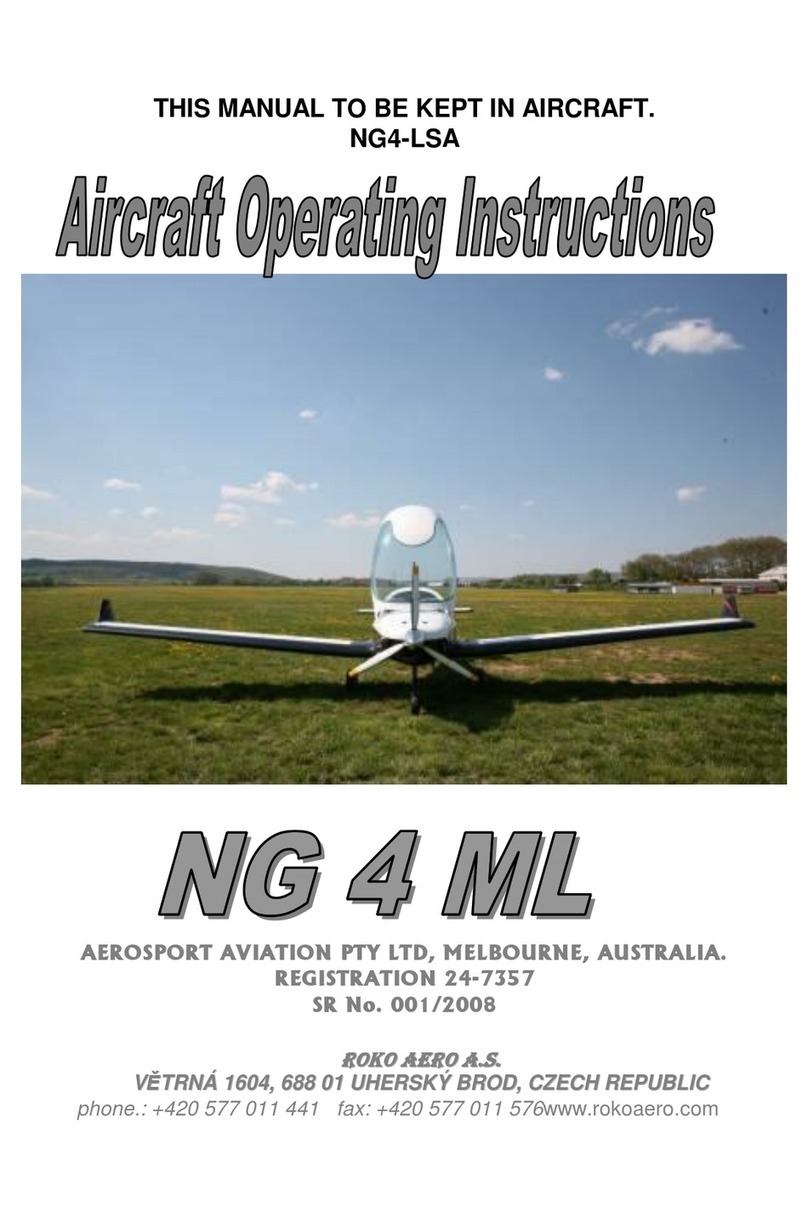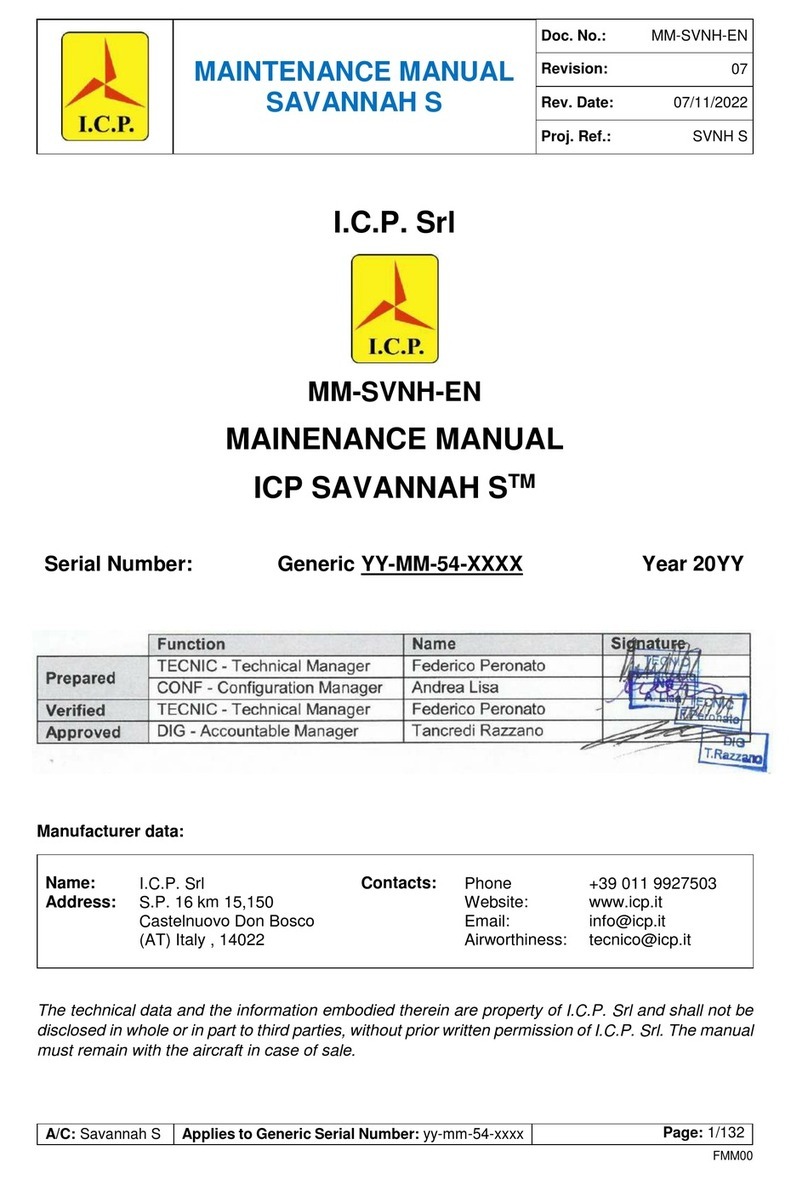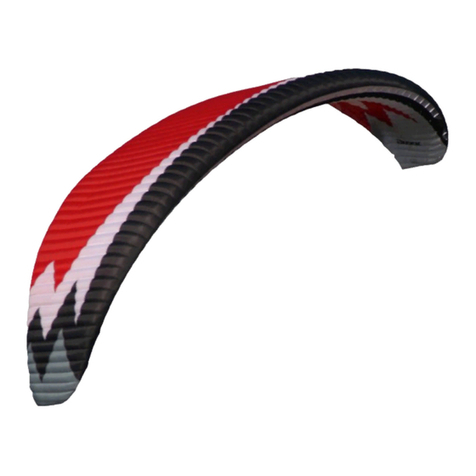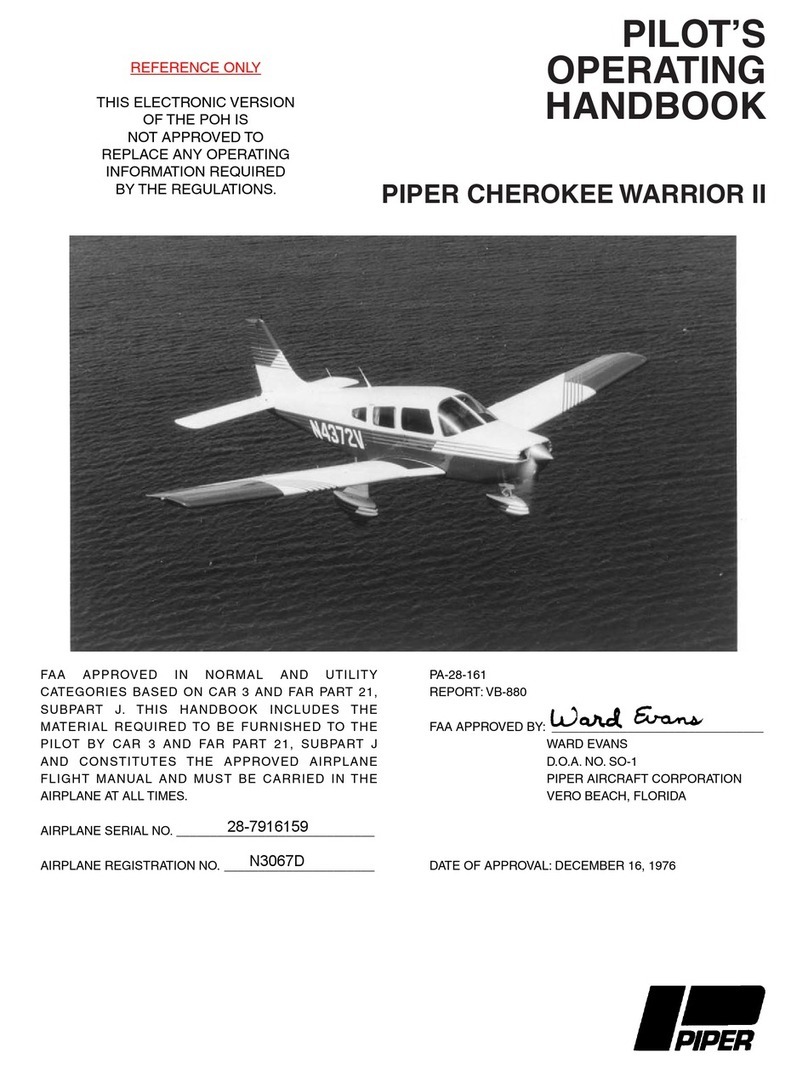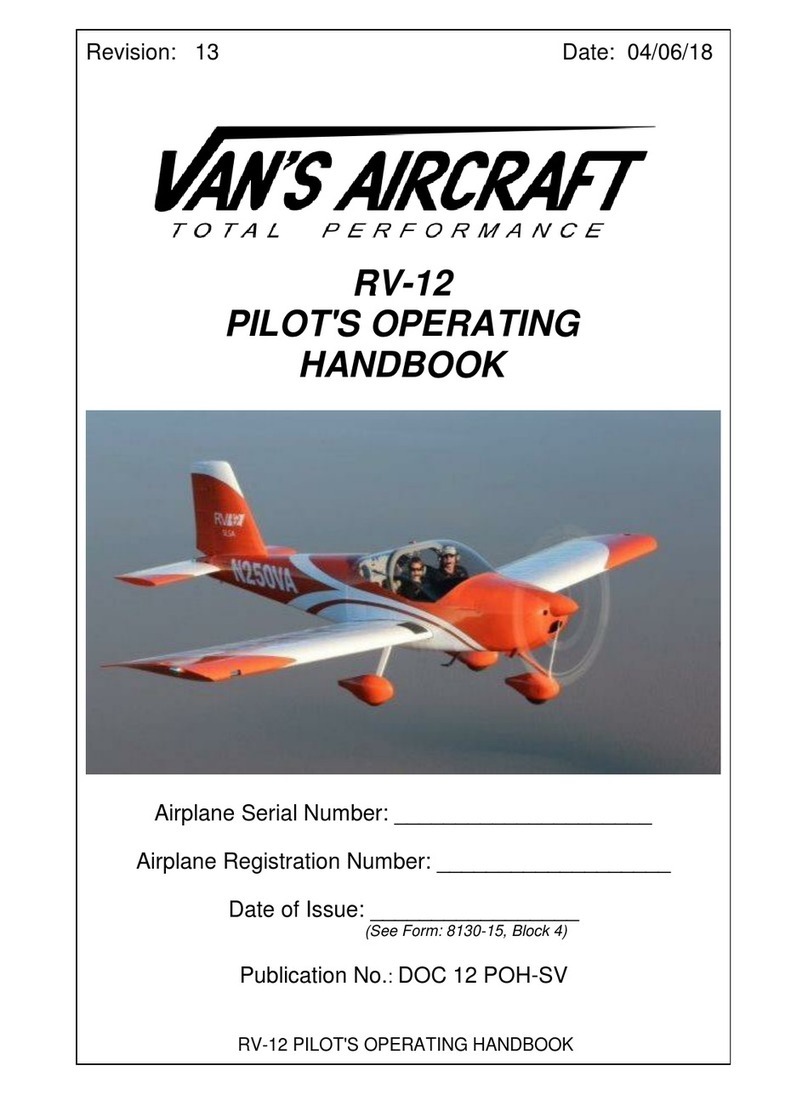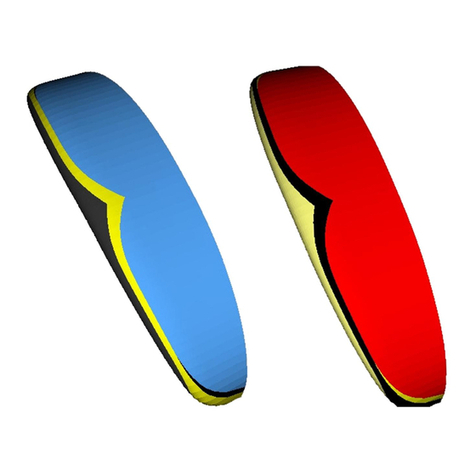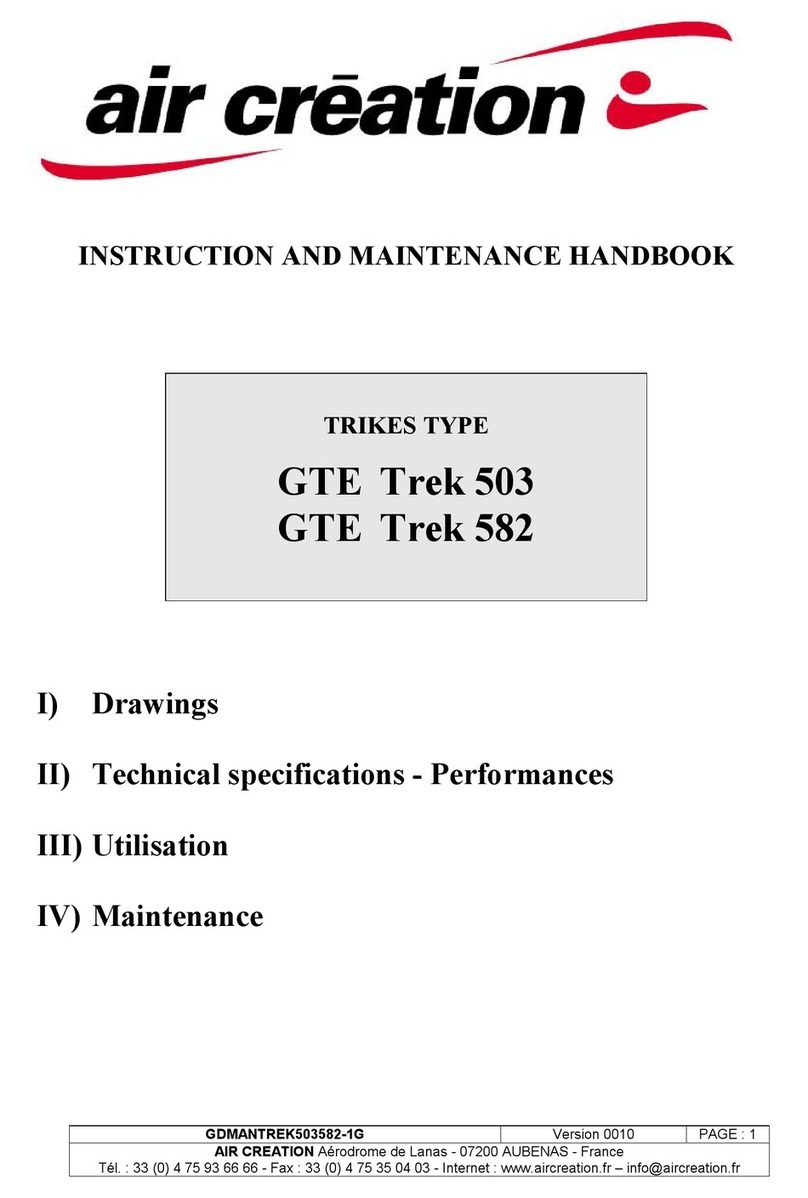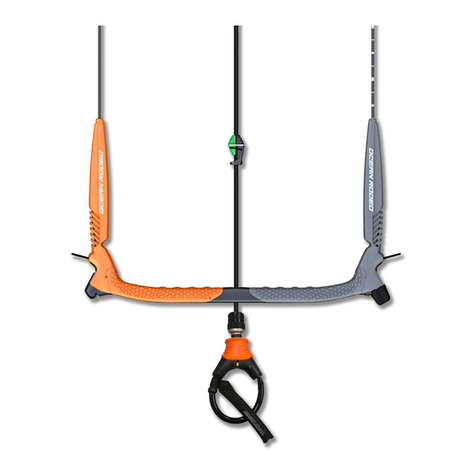Evektor SportStar MAX Owner's manual

Revision 1.50
Effective Date:
7/12/2011
Pilot Operating Handbook

Pilot Operating
Handbook
2
Pilot Operating Handbook
This manual must be on the airplane board during operation. This manual contains information
which must be provided to the pilot and also contains supplementary information provided.
This aircraft must be operated in compliance with the information and limitations stated in this
manual.
Table of Contents
1. Introduction.................................................................................................................... 2
SECTION 2 - LIMITATIONS AND MARKINGS............................................................................ 8
SECTION 3 - EMERGENCY PROCEDURES ...............................................................................20
SECTION 4 - NORMAL PROCEDURES.....................................................................................28
SECTION 5 - PERFORMANCE................................................................................................43
SECTION 6 - WEIGHT AND BALANCE ....................................................................................59
SECTION 7 - AIRPLANE AND SYSTEM DESCRIPTION...............................................................68
SECTION 8 - END USER LICENSE AGREEMENT.......................................................................81
1. Introduction
1.1 Pilot Responsibility
There are inherent risks in participating in aviation activities, these risks are significant, up to and
potentially including death. Operators and passengers of recreational aviation aircraft, by
participation, accept the risks inherent in such participation of which the ordinary prudent person is
or should be aware. Pilots and passengers have a duty to exercise good judgment and act in a
responsible manner while using the aircraft and to obey all oral or written warnings, or both, prior
to and/or during use of the aircraft.
This Aircraft Operating Instructions has been prepared to provide pilots and instructors with
information for safe and efficient operation of the SportStar MAX airplane. It also contains
supplementary information considered to be important by the airplane manufacturer.
1.2 Certification basis
SportStar MAX complies with the ASTM F2245-07a Standard Specification for Design and
Performance of a Light Sport Airplane, issued by ASTM International Committee F37.
IFR version complies with FAR 91.205 requirements, as well as with F2245 Annex A3 Additional
Requirements for Light Sport Airplanes Operated Under Instrument Flight Rules, as known till

Pilot Operating
Handbook
3
1.3 Warnings, Cautions, Notes
The following information applies to warnings, cautions and notes used in the Aircraft Operating
Instructions:
WARNING
MEANS THAT NON-OBSERVATIONS OF THE CORRESPONDING PROCEDURE
LEADS TO AN IMMEADIATE OR IMPORTENT DEGRADATION OF THE FLIGHT
SAFETY.
CAUTION
MEANS THAT NON-OBSERVATIONS OF THE CORRESPONDING PROCEDURE
LEADS TO A MINOR OR TO A MORE OR LESS LONG TERM DEGRADATION OF
THE FLIGHT SAFETY.
NOTE
Draws the attention to any special item not directly related to safety but which is
important or unusual.
1.4 Descriptive data
1.4.1 AIRPLANE DESCRIPTION
SportStar MAX airplane is a metal-composite low-wing monoplane of semimonocoque structure
with two side by side seats and steerable nose wheel landing gear.
For further description see Section 7 - Airplane and system description.
1.4.2 POWERPLANT
The standard powerplant consists of ROTAX 912ULS (100 hp) engine and ground adjustable, 3-
bladed, WOODCOMP KLASSIC 170/3/R propeller.
IFR version is fitted with certified ROTAX 912S2 engine and ground adjustable, 3-bladed,
composite Warpdrive CF prop, with Nickel protection of blade leading edges.
For further description see Section 7 - Airplane and system description.
1.4.3 MAIN TECHNICAL DATA
Wing
Span
28.37 ft
Area
112.7 sq.ft
MAC depth
4.1 ft
Wing loading
11.71 lbs/sq.ft
Aileron area
2.62 sq.ft
Flap area
5.60 sq.ft
Fuselage
Length
19.62 ft
Width
3.55 ft
Height
8.12 ft
Cockpit Max. Width
3.9 ft

Pilot Operating
Handbook
4
Horizontal Stabilizer
Span
8.20 ft
HTU Area
20.88 sq.ft
Elevator area
8.40 sq.ft
Vertical Stabilizer
Height
4.21 ft
VTU Area
10.93 sq.ft
Rudder area
4.67 sq.ft
Landing Gear
Wheel track
6.39 ft
Wheel base
4.43 ft
Wheel diameter
15 in
1.4.1 THREE-VIEW DRAWING

Pilot Operating
Handbook
5
Figure 1-1

Pilot Operating
Handbook
6
1.5 Definitions And Abbreviations
NOTE
The abbreviations on placards in the airplane cockpit, are printed in
BOLD CAPITAL LETTERS in the text of this Aircraft Operating
Instructions.
ACCU
accumulator
ALT ENC
encoding altimeter
ATC
air traffic control
bar
1 bar = 100 kPa
BEACON
anti-collision beacon
°C
Degrees Celsius
CAS
calibrated airspeed
CLOCK
aircraft clock
ft
foot 1 ft = 0.305 m
GPS
global positioning system
HTU
horizontal tail unit
IAS
indicated airspeed
IC
intercom
IFR
instrument flight rules
ISA
international standard atmosphere
kg
kilogram
KIAS
indicated airspeed in knots
KCAS
calibrated airspeed in knots
mph
miles per hour
mph CAS
calibrated airspeed in miles per hour
km/h CAS
calibrated airspeed in km/h
kts
knots 1 kt = 1.852 km/h
lbs
pounds 1 lb = 0.45 kg
m
meter
MAC
mean aerodynamic chord
max.
maximum
min.
minimum or minute
mm
millimeter
m/s
meter per second
OAT
outside air temperature
OFF
system is switched off or control element is in off-position
ON
system is switched on or control element is in on-position
Pa
Pascal 1Pa = 1N/m2
PSI
pound per sq.in (1PSI = 6.89 kPa)
RPM
revolutions per minute
RWY
runway
sq.ft
square foot
sq.m
square meter
VA
maneuvering airspeed
VFE
maximum flap extended speed - flaps in 50° position
VFR
visibility flight rules
VLOF
airplane lift-off speed
V-METER
voltmeter
VNE
never exceed speed

Pilot Operating
Handbook
7
VNO
maximum structural cruising speed
VSO
stall speed with wing flaps in 50° position
VS1
stall speed with wing flaps in 0° position
VTU
vertical tail unit
VX
best angle-of-climb speed
VY
best rate-of-climb speed
XPDR
transponder
Intentionally Left Blank

Pilot Operating
Handbook
8
SECTION 2 - LIMITATIONS AND MARKINGS
2.1 Introduction.......................................................................9
2.2 Airspeed.............................................................................9
2.3 Airspeed indicator marking............................................10
2.4 Powerplant.......................................................................11
2.5 Powerplant instrument marking.....................................12
2.6 Miscellaneous instrument marking................................12
2.7 Weight..............................................................................12
2.8 Centre of gravity..............................................................12
2.9 Approved Maneuvers......................................................13
2.10 Manevering Load Factors...............................................13
2.11 Flight crew.......................................................................13
2.12 Operation Types .............................................................14
2.13 Fuel...................................................................................15
2.14 Oil.....................................................................................16
2.15 Maximum number of passengers...................................16
2.16 Other limitations..............................................................16
2.17 Limitation placards .........................................................17

Pilot Operating
Handbook
9
2.1 Introduction
Section 2 contains operation limitation, instrument marking and basic placards necessary for safe
operation of airplane and its engine, standard systems and equipment.
Limitation for optional systems and equipment are stated in section 9 - Supplements.
2.2 Airspeed
Airspeed limitations and their meaning for operation are stated in the table below:
Speed KIAS mph IAS Meaning
VNE Never exceed speed
146 168 Do not exceed this speed in any
operation.
VNO Maximum structural
cruising speed 115 132 Do not exceed this speed, with
exception of flight in smooth air, and
even then only with increased caution.
VAManeuvering speed 90 106 Do not make full or abrupt control
movement above this speed, because
under certain conditions the aircraft may
be overstressed by full control
movement.
VFE Maximum flap
extended speed 70 81 Do not exceed this speed with the given
flap setting.

Pilot Operating
Handbook
10
2.3 Airspeed indicator marking
Airspeed indicator markings and their color-code significance are shown in the table below:
Marking Range Meaning
KIAS mph IAS
Red line 37 43 VS0 at maximum weight (flaps in landing
position 50°)
White arc 37 - 70 44 – 81 Operating range with extended flaps.
Lower limit- VS0 at maximum weight
(flaps 50°)
Upper limit - VFE
Green arc 38 - 115 49 – 132 Normal operation range
Lower limit - VS1 at maximum weight
(flaps 0°)
Upper limit - VNO
Yellow arc 115 - 146 132 - 168 Maneuvers must be conducted with
caution and only in smooth air
Red line 146 168 Maximum speed for all operations - VNE.

Pilot Operating
Handbook
11
2.4 Powerplant
Engine manufacturer: Bombardier-Rotax GMBH
Engine type: ROTAX 912 ULS (S2 for IFR version)
Power: maximum take-off 73.5 kW / 100 HP
maximum continuous 69 kW / 95 HP
Engine speed: maximum take-off 5800 RPM
max. 5 minutes
maximum continuous 5500 RPM
idle 1400 RPM
Cylinder head
temperature: maximum 275 °F
Oil temperature: maximum 266 °F
optimum operation 190 - 230 °F
Oil pressure: maximum 102 PSI
minimum 12 PSI
optimum operation 29 - 73 PSI
Fuel pressure: minimum 2.2 PSI
Fuel grades: see 2.13,
Oil grades: see 2.14,
Reducer gear ratio: 2.43 : 1
Propeller:
Standard installed:
IFR version:
Prop manufacturer:
WOODCOMP s.r.o.
Warpdrive
Propeller type: KLASSIC 170/3/R
3 blade
composite
ground adjustable
Warpdrive CF Nickel protection of blade leading edges
3-bladed, composite
Ground adjustable
Propeller diameter:
68 in
68 in
Maximum prop speed:
2600
RPM
2600 RPM
NOTE
If installed a different propeller type - see section 9 - Supplements for
propeller limitations.

Pilot Operating
Handbook
12
2.5 Powerplant Instrument Marking
The color-code of instruments is shown in the following table:
Instrument Units Red line Green arc Yellow arc Red line
Lower limit Normal
operation
range
Caution range Upper limit
RPM indicator RPM - 1400 - 5500 5500 - 5800 5800
Oil temperature
indicator °F - 190 - 230 120 - 190
230 - 266 266
Oil pressure
indicator PSI 12 29 - 73 12 - 29
73 - 102 102
Cylinder head
temperature °F - - - 275
2.6 Miscellaneous instrument marking
There are not other instruments with color marking.
2.7 Weight
Empty weight (average equipment)
740 lbs ± 2 %
Maximum take-off weight
1320 lbs
Maximum landing weight
1320 lbs
Maximum weight in baggage compartment
55 lbs
WARNING
DO NOT EXCEED MAXIMUM WEIGHTS! THEIR EXCEEDING LEADS TO
AIRPLANE OVERLOADING AND TO DEGRADATION OF FLIGHT
CHARACTERISTICS AND DETERIORATION OF MANOEUVRABILITY.
2.8 Centre of gravity
Empty airplane C.G. position (standard equipment)
20 ± 2 % MAC
Operating C.G. range
20 to 34 % MAC
Reference datum is the wing leading edge.

Pilot Operating
Handbook
13
2.9 Approved Maneuvers
SportStar MAX airplane is approved to perform the following maneuvers:
- steep turns up to bank angle of 60°
- climbing turns
- lazy eights
- stalls (except for steep stalls)
- normal flight maneuvers
WARNING
AEROBATICS AS WELL AS INTENTIONAL SPINS ARE PROHIBITED!
2.10 Maneuvering Load Factors
Maximum positive load factor
4.0
Maximum negative load factor
-2.0
2.11 Flight crew
Minimum crew
1 pilot
Minimum weight of crew
121 lbs
Maximum weight of crew acc. to chapter 6.
WARNING
DO NOT EXCEED MAXIMUM WEIGHTS! THEIR EXCEEDING LEADS TO AIRPLANE
OVERLOADING AND TO DEGRADATION OF FLIGHT CHARACTERISTICS AND
DETERIORATION OF MANOEUVRABILITY.

Pilot Operating
Handbook
14
2.12 Operation Types
The airplane is approved for VFR daylight flights.
WARNING
NIGHT FLIGHTS ACCORDING TO VFR, FLIGHTS ACCORDING TO IFR (BY INSTRUMENTS) ARE
APPROVED ONLY WHEN INSTRUMENTATION REQUIRED FOR SUCH FLIGHTS IS INSTALLED
AND FLIGHT PERFORMED BY A PILOT WITH APPROPRIATE RATING!
NOT AUTHORIZED FOR FLIGHT INTO KNOWN OR FORECAST POSSIBLE ICING CONDITIONS.
NOT AUTHORIZED FOR FLIGHT WITHIN 25 MILES OF KNOWN LIGHTNING OR
THUNDERSTORMS.
2.121 INSTRUMENTS AND EQUIPMENT FOR DAY VFR FLIGHTS:
1 Airspeed indicator (the color marking according to par. 0)
1 Sensitive barometric altimeter
1 Magnetic compass
1 Fuel gauge indicator
1 Oil temperature indicator
1 Oil pressure indicator
1 Cylinder head temperature indicator
1 Engine speed indicator
1 Safety harness for every used seat
2.122 INSTRUMENTS AND EQUIPMENT FOR NIGHT VFR FLIGHTS:
F 2245 Annex 2 LSA to be flown at night
2.123 INSTRUMENTS AND EQUIPMENT FOR IFR FLIGHTS:
FAR 91.205 and F2245 Annex 3 Additional Requirements for Light Sport Airplanes Operated Under
Instrument Flight Rules, as proposed till 1.1.2009.
Refer to Supplement IFR to this standard Aircraft Operating Instructions
CAUTION
ADDITIONAL EQUIPMENT NECESSARY FOR AIRPLANE OPERATION IS GIVEN IN
APPROPRIATE OPERATION REGULATION OF AIRPLANE OPERATOR’S
COUNTRY.

Pilot Operating
Handbook
15
2.13 Fuel

Pilot Operating
Handbook
16
Fuel tank volume (each)
15.85 U.S. gallons
Total
31.7 U.S. gallons
Usable fuel
31.2 U.S. gallons
Unusable fuel
0.5 U.S. gallons (0.25 US gal per tank)
NOTE
It is not recommended to fully tank the fuel tanks.
Due to fuel thermal expansion keep about 2.11U.S. gallons
of free space in the tank to prevent fuel bleed through the
vents in the wing tips thus preventing environmental
contamination. This should be adhered especially when
cold fuel from an underground tank is tanked.
2.14 Oil
Performance classification SF, SG according to API
Oil volume:
- minimum 0.53 U.S. gallons
- maximum 0.79 U.S. gallons
2.15 Maximum Number Of Passengers
Maximum number of passengers including pilot 2
2.16 Other limitations
SMOKING IS PROHIBITED on the airplane board.
PASSENGER NOTICE
This aircraft conforms to ASTM Consensus Standards of airworthiness developed and maintained by the
aviation community under ASTM Technical Committee F37.
PASSENGER WARNING !
This aircraft was manufactured in accordance with Light Sport Aircraft airworthiness standards and does
not conform to standard category airworthiness requirements.

Pilot Operating
Handbook
17
2.17 Limitation Placards
The following placards are located on the instrument panel:
The following placards are located on the the tilting canopy:
This placard is located on the top of fixed rear canopy:
NOTE
For painted top of the rear glass the latch is visible
when looking sideways from under the painted area.
These placards are located on the tip-up canopy close to rear guide pins:
The following placard is located in the baggage compartment:

Pilot Operating
Handbook
18
The following placard is located behind the baggage compartment:
It prohibits use of that place for additional stowage due to airplane aft C.G. limit.
The following placards are located on sides of the tip-up canopy:
Day VFR airplane
Or (Night VFR airplane)
or (IFR airplane)
and (all versions)
This Light Sport Aircraft has been approved
by the Manufacturer for IFR flights with the
following limitations:
Not authorized for IFR flights into known
or forecast possible icing conditions.
Not authorized for IFR flights within 25
miles
o

Pilot Operating
Handbook
19
NOTE
The values stated on the placard “LOAD LIMITS” are valid for the
empty weight of the airplane with average equipment. The placard
with values valid for the actual empty weight of the airplane will
be placed in the cockpit.
Other placards and labels are shown in Aircraft Maintenance and Inspection Procedures.
This Space Left Intentionally Blank
Max.take-off weight 1320 lbs
Empty weight 700 lbs
Max.baggage weight 55 lbs
PERMITTED CREW WEIGHT [lbs]
30,0 25,0 20,0 15,0 10,0 5,0
max. 55 lbs
385 415 445 475 505 535
1/2 28 lbs
412 442 472 502 532 562
No baggage
440 470 500 530 560 590
Fuel reserve 2 U.S. gallons
Fuel quantity U.S.gal.
Baggage
weight
LOAD LIMITS

Pilot Operating
Handbook
20
SECTION 3 - EMERGENCY PROCEDURES
3.0 Introduction.....................................................................21
3.1 Speeds for Performing Emergency Procedures ...........21
3.2Engine Failure .................................................................21
3.3Engine Starting in Flight.................................................22
3.4Engine Fire.......................................................................23
3.41 Fire On The Ground..........................................................23
3.41 Fire During Takeoff ...........................................................23
3.41 Fire In Flight ......................................................................24
3.5Fire In The Cockpit..........................................................24
3.6Gliding Flight...................................................................25
3.7Emergency Landing........................................................25
3.8Unintentional Spin Recovery..........................................26
3.9Other Emergency Procedures........................................26
3.91 Virbration...........................................................................26
3.92 Carberator Icing ................................................................27
Other manuals for SportStar MAX
2
Table of contents
Other Evektor Aircraft manuals
Popular Aircraft manuals by other brands

Daher
Daher TBM 900 Pilot's information manual
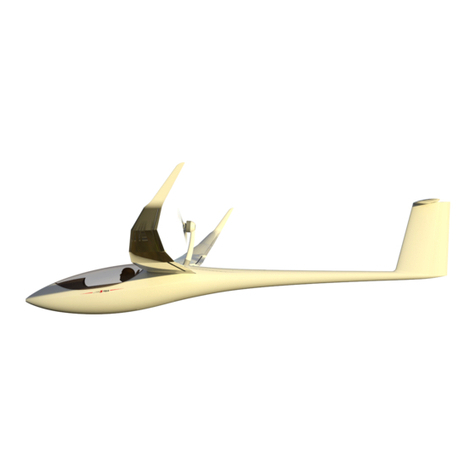
Jonker Sailplanes
Jonker Sailplanes JS3 Airplane Flight Manual

Tecnam
Tecnam P2006T Flight manual
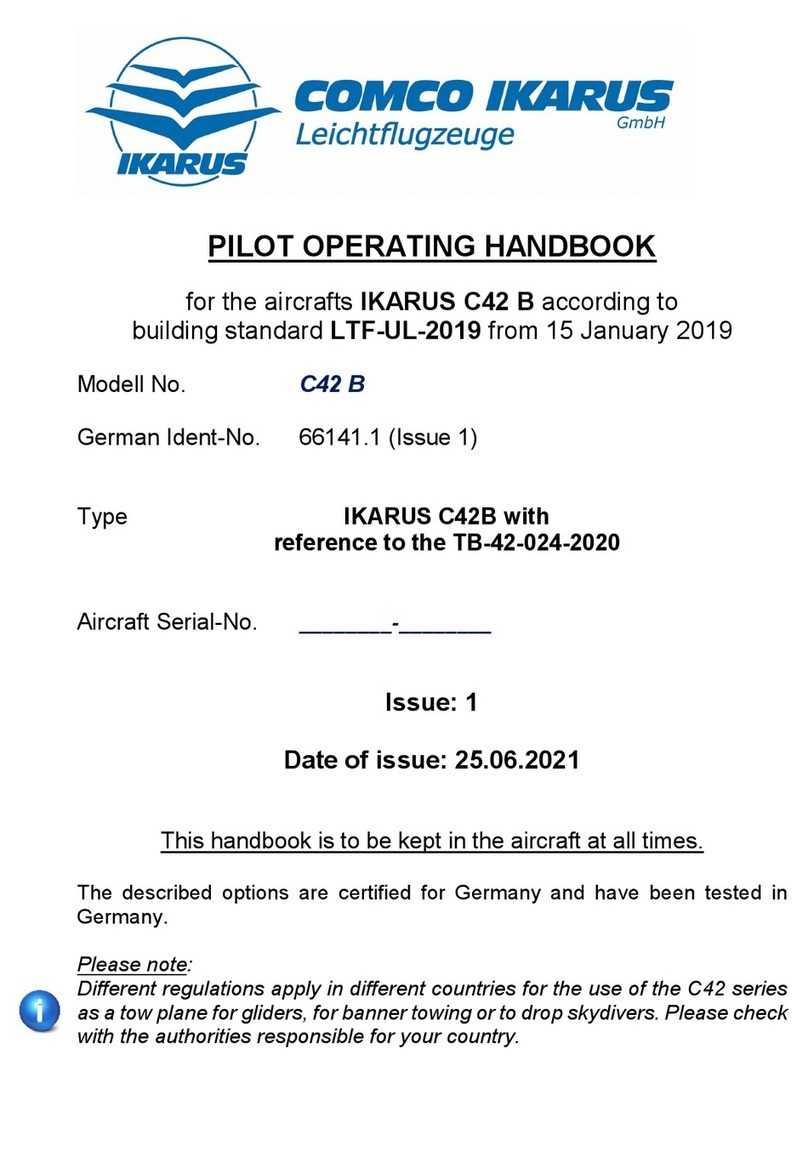
Comco Ikarus
Comco Ikarus C42 B Pilot operating handbook

Cessna
Cessna 1980 172RG Cutlass Pilot operating handbook
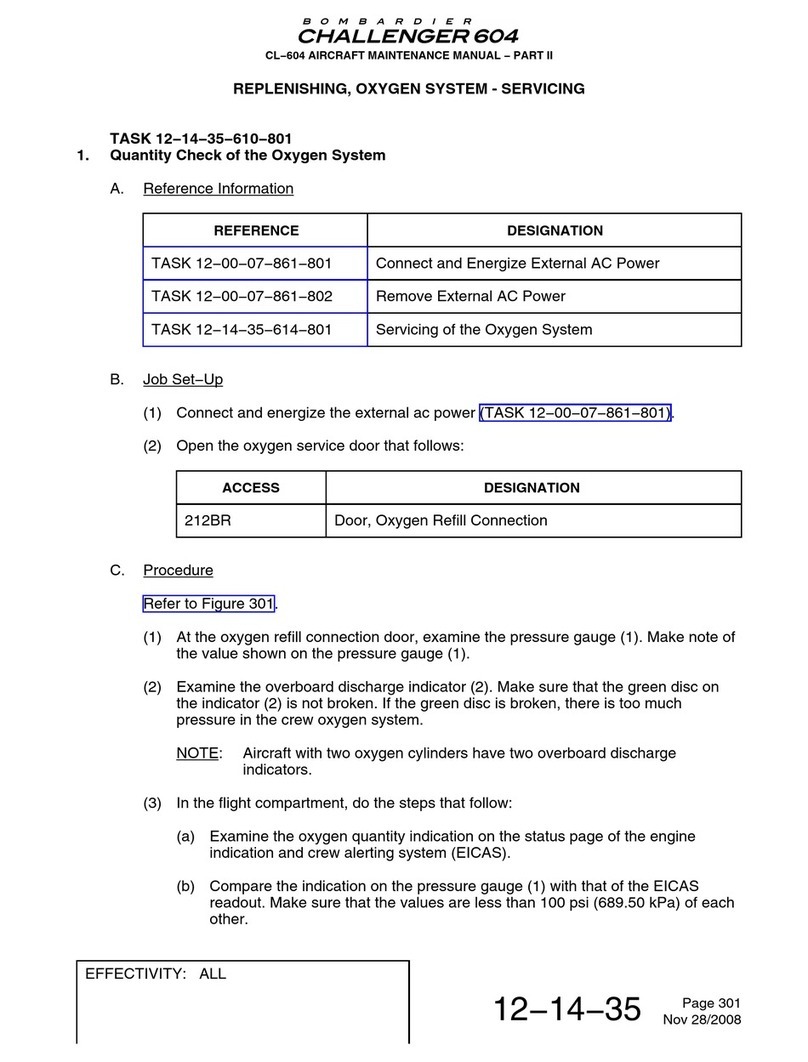
BOMBARDIER
BOMBARDIER CHALLENGER 604 Maintenance manual

